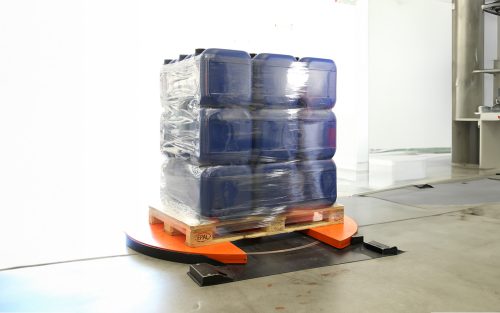
FAQs about Stretch Films
The most common questions from our customers at a glance
Questions about stretch films and their applications
Achieve your processing goals quicker with expert advice from us
We offer our customers a range of solutions, not just in respect of the film. With the expert help of our knowledgeable consultants, we find the right solution to our customers’ questions and issues, whether on-site or remotely. Tips and hints about our films can be found in our application instructions.
Questions about Stretch Films
General questions from correct storage to differences in film types
Through the combination of higher quality raw materials and manufacturing processes, premium films achieve better mechanical properties. Compared to our standard films, premium films excel with higher holding forces resulting in better pallet stability and unit load securing. Thanks to the excellent mechanical properties, our premium film solutions achieve higher stretch values which not only saves you material but also reduces your costs per wrapped unit.
No – each stretch wrapper has different requirements for stretch film. To achieve the best result it is essential that the film type used is precisely tailored to your stretch wrapper. This is where the expertise of our consultants comes in and they will be happy to help you. If you have various stretch wrappers in use, it may be necessary to use different stretch film solutions or parameter settings.
Store your film in-house and protect it from UV radiation, moisture, and other weather conditions. The optimal temperature for storing our stretch films is between 10°C and 30°C, with a relative humidity of 25% to 60%. Do not store our films for longer than one year. To avoid external damage, do not stack more than 2 pallets on top of each other. Before processing, the films should be stored at the processing location for at least 24 hours so that the stretch film products can adapt to the room temperature and conditions.
The decision here depends on your product and packaging processes, the stretch volume and the cycle rate of your packaging units.
Hand stretch film is easier to use, more flexible, and cost-effective. It is especially suitable for different pallet types and low stretch volumes.
Machine stretch film is fast, consistent, and efficient. It is well suited to larger stretch requirements with an automatic stretch wrapper. Through automation, your load units are consistently stretched with consistent quality, ensuring optimal results every time.
For products used with hot and cold contents such as cans or beverages, our perforated stretch films are particularly suitable. But even products that are filled with cold contents tend to condensate when stretched. The macro-perforated film allows air to circulate allowing moisture to escape. This prevents sweating of your goods and spoilage due to mould.
.
For delicate products such as food or young plants, our perforated stretch film is particularly suitable. The macro-perforated film allows air to circulate allowing moisture to escape. This prevents premature spoilage of food and flowers.
.
Your question wasn’t included? Then write to us.
We will take care of the response as quickly as possible.
Questions about the properties of our films
Special properties, UV resistance and food safety
Coloured stretch films protect against theft and serveas a visual barrier. They can also be used to complement or reflect a company colour or as a way of maintaining an overview in large warehouses. The colour of the film also indicates something about its possible application areas.
In this context:
- White stands for UV repellent
- Black for sun absorbing
- and Blue for the food industry.
The various colours of stretch films can provide clues about their areas of application and use but can also be requested specifically by the customer. For example, the film can be not only coloured as a visual barrier but also manufactured in the corresponding corporate colours.
Stretch films are a thermoplastic product, which is not automatically UV-resistant. Only through the addition of certain additives does, for example, a black stretch film become a UV-resistant film that reliably protects its products from UV radiation for up to 12 months.
Stretch film is not automatically food grade approved. We offer a variety of our films with food grade certification. We pay special attention to the origin and processing of our raw materials and can provide a statement of food grade conformity.
Your question wasn’t included? Then write to us.
We will take care of the response as quickly as possible.
Questions about Sustainability
Recyclability, Recycled Solutions and Other Questions
PCR (Post Consumer Recycled) refers to plastic waste generated by end consumers, as well as packaging waste from retailers, supermarkets, and distribution channels.
PIR (Post Industrial Recycled) includes waste from production, such as start-up and changeover, scrap or rejections. Trimmings that are already recycled during production and not separately collected beforehand are not included.
With the POLIFLEXX reNATE series of stretch film solutions, we provide an environmentally conscious alternative for those who prioritize sustainability. Our films with recycled content, thanks to their excellent mechanical properties and unique formulations, can be used on all common stretch wrapping machines and are on par with regular film solutions in every detail.
Our stretch films are 100% recyclable.





